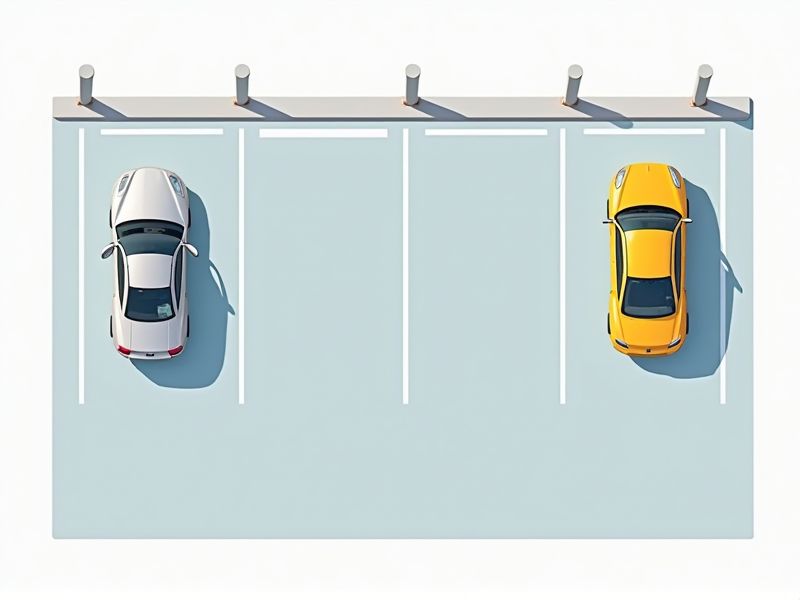
Standard parking space dimensions vary by location, but in most areas, a typical parking space measures about 9 feet wide by 18 feet long. These dimensions provide enough room for most cars to park comfortably and allow passengers to enter and exit vehicles safely. It's important to note that spaces for compact vehicles can be slightly smaller, while accessible (handicap) parking spots are usually wider--often around 12 feet--to accommodate wheelchair access. Checking local codes or property requirements is always recommended for precise sizing in your specific area.
Width: 8.5 To 9 Feet
A standard parking space typically measures between 8.5 to 9 feet in width, ensuring sufficient room for vehicle access and maneuverability. This width accommodates most passenger vehicles, allowing for comfortable entry and exit from the driver's side. In urban areas, the dimensions may be adapted based on space constraints, with some lots implementing narrower spaces. Understanding these measurements is essential for optimizing your parking experience, particularly in crowded environments.
Length: 18 To 20 Feet
A standard parking space typically measures between 18 to 20 feet in length, accommodating most vehicles comfortably. This length ensures that vehicles, including sedans, SUVs, and trucks, can park without encroaching on adjacent spaces. For optimal accessibility, parking lot regulations often stipulate a minimum of 9 feet in width per space, enhancing maneuverability for drivers. Ensuring your parking area meets these dimensions can improve efficiency and safety for all users.
Aisle Width: 12 To 24 Feet
A standard parking space typically measures 9 feet in width and 18 feet in length, accommodating various vehicle sizes. Aisle width is crucial for maneuverability, with standard recommendations ranging from 12 to 24 feet, ensuring easy navigation for larger vehicles and minimizing accident risks. In settings like shopping centers or airports, maintaining the appropriate aisle width supports efficient traffic flow and enhances user experience. Understanding these dimensions can help you plan or select areas for parking efficiently, prioritizing safety and accessibility.
Compact Space: 7.5 To 8 Feet Wide
A compact parking space typically measures between 7.5 to 8 feet in width, catering specifically to smaller vehicles. These spaces are designed to maximize parking efficiency while ensuring safe access for drivers. Regulations often require a minimum length of 15 to 18 feet for compact spaces, allowing sufficient room for parking maneuvers. When utilizing compact parking in your area, be aware that these dimensions may vary based on local codes and standards.
Oversized Vehicle Space: 10 To 12 Feet Wide
Standard oversized vehicle parking spaces typically range from 10 to 12 feet in width, accommodating larger vehicles such as vans, SUVs, and pickups. These spaces are specifically designed to ensure safe and convenient parking for oversized vehicles, minimizing the risk of damage to surrounding vehicles. The American Disabilities Act (ADA) also mandates specific width requirements for accessible parking, often exceeding the standard widths for oversized vehicles. You should always check local regulations to ensure compliance with any specific requirements for oversized vehicle parking in your area.
Parallel Parking Width: 8 Feet
The standard parallel parking space width is set at 8 feet, ensuring adequate room for most vehicles. This measurement accommodates a variety of car sizes, from compact models to larger sedans, promoting ease of entry and exit. In urban planning, these spaces are typically designed to enhance safety and accessibility for drivers and pedestrians alike. Ensuring your vehicle fits within this dimension can prevent potential damage and facilitate efficient parking.
Handicap Space Width: 13 To 16 Feet
The standard width for a handicap parking space ranges from 13 to 16 feet, providing ample room for individuals with disabilities to maneuver safely. This space must be designed to accommodate vehicles with accessible features, ensuring ease of entry and exit for wheelchair users. In many jurisdictions, these designated spaces are positioned close to building entrances to enhance accessibility for users. Compliance with local regulations is essential to ensure that the parking areas meet the necessary safety and convenience standards for all drivers.
Incline Or Slope: 1.5% To 6%
The standard for parking space slopes mandates an incline of 1.5% to 6% to ensure proper drainage and accessibility. This range allows for effective water runoff while maintaining user comfort. A slope exceeding 6% may pose challenges for both disabled individuals and vehicles, leading to potential safety concerns. When designing or constructing parking areas, adhering to these specifications is crucial for functionality and compliance with building codes.
Buffer Zones Or Markings
A standard parking space typically measures 9 feet in width and 18 feet in length, ensuring sufficient room for vehicles. Buffer zones, usually 3 to 5 feet wide, are crucial for preventing door dings and allowing safe pedestrian movement. Clear markings, such as painted lines and symbols, enhance visibility and safety, guiding drivers and users effectively. Investing in well-defined parking standards can significantly improve the functionality of parking areas while enhancing user experience.
Vertical Clearance: 6.5 To 7 Feet
A standard parking space typically requires a vertical clearance between 6.5 to 7 feet, ensuring adequate space for vehicles of varying heights. This measurement is crucial for accommodating larger vehicles such as vans and SUVs, which often exceed the height of conventional cars. By adhering to these standards, parking facilities can enhance accessibility and safety for all users. Ensuring proper clearance can also prevent damage to both vehicles and the parking structure itself.
